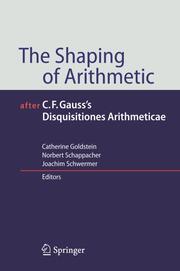Detailansicht
The Shaping of Arithmetic after C.F.Gauss's Disquisitiones Arithmeticae
ISBN/EAN: 9783642058028
Umbreit-Nr.: 1578129
Sprache:
Englisch
Umfang: xii, 578 S., 36 s/w Illustr., 578 p. 36 illus.
Format in cm:
Einband:
kartoniertes Buch
Erschienen am 12.02.2010
Auflage: 1/2007
- Kurztext
- Assesses the impact of the Disquisitiones, in the 200 years since its publication Focuses on responses of specific mathematicians Explores the influence of the Disquisitiones as a source of mathematical inspiration Contributors include mathematicians, historians, philosophers
- Autorenportrait
- Catherine Goldstein is Directrice de recherches du CNRS and works at the Institut de mathématiques de Jussieu (Paris, France). She is the author of "Un théorème de Fermat et ses lecteurs" (1995) and a coeditor of "Mathematical Europe: History, Myth, Identity"(1996). Her research aims at developing a social history of mathematical practices and results, combining close readings and a network analysis of texts. Her current projects include the study of mathematical sciences through World War I and of experimentation in XVII th-century number theory.Norbert Schappacher is professor of mathematics at Université Louis Pasteur, Strasbourg.His mathematical interests relate to the arithmetic of elliptic curves.But his current research projects lie in the history of mathematics. Specifically, he focuses on the intertwinement of philosophical and political categories with major junctures in the development of mathematical disciplines in the XIX\up{th} and XX\up{th} centuries. Examples include number theory and algebraic geometry, but also medical statistics. Joachim Schwermer is professor of mathematics at University of Vienna. In addition, he serves as scientific director at the Erwin-Schroedinger International Institute for Mathematical Physics, Vienna. His research interests lie in number theory and algebra, in particular, in questions arising in arithmetic algebraic geometry and the theory of automorphic forms. He takes a keen interest in the mathematical sciences in the XIX\up{th} and XX\up{th} centuries in their historical context.
